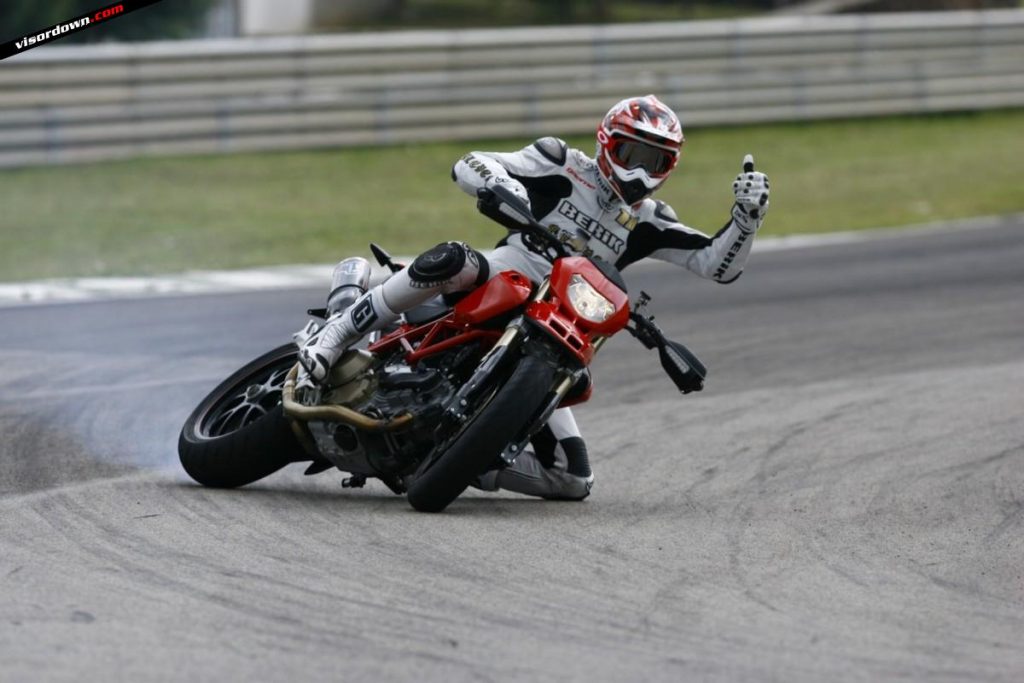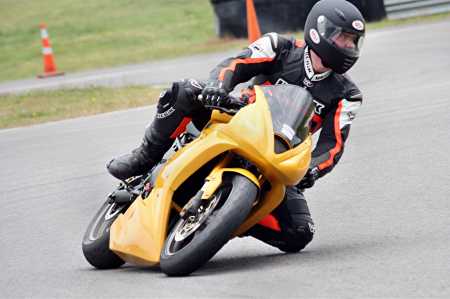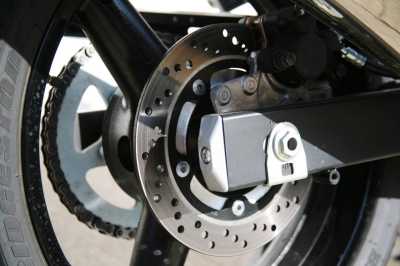Getting a vehicle to go around a corner is a tricky thing.
Bikes, do not, contrary to popular belief, travel around a circle. Let me explain.

Imagine a wheel tied to a piece of string which is in turn tied to a stake in the ground. Then push that wheel so that is rolls around the circle out from the stake at speed.
Whilst that wheel is rolling around in circles the string will be tight because the wheel will be trying to head off in an arc and continually be corrected by the string. We know this as basic physics and we call this phenomenon Centrifugal Force, and we even have formulas to calculate the force.
Formula
| = | centrifugal force | |
| = | mass | |
| = | angular velocity | |
| = | distance from the origin |
From the web
Use the centrifugal force equation: F = m v² / r
Centrifugal Force Calculator
If this were our motorcycle tyre going around a 200m Radius corner with 200kg of weight at 60mph, there would be nearly 720Newtons of force on that “string” (using the calculator above).
But of course on our motorbike we don’t have a string, tying us to the inside of the corner. Instead the tyres try to resist this force using their Co-efficient of Friction (CoF) (grip) against the road and a thing called angular displacement. i.e. we turn a little more into the corner than we would need to, to just roll around the arc if there was no centrifugal force.

The result of this is that your tyre is pulled inward, or more accurately your rim is pushed outward and this distorts the tyre rubber, meaning the rubber that is about to roll onto the road and take its turn in resisting this centrifugal force is further outside the perfect circle than the piece holding the force right now.
To envisage this, think about a circle drawn on the table, you place a hand down to represent the tyre patch and then your next hand represents the next patch as the tyre rotates along the circle. But as each hand goes in front of the last, it is pushed slightly to the outside by the tyre distortion and so you effectively “walk” a slightly wider path.
This demonstrates treadwalk. Your tyre, in trying to resist the forces applied to it by centrifugal force (and other forces we’ll talk about soon), distorts and “walks” toward the outside of the arc of the turning circle.
Ok. So now you should understand basic “treadwalk”, think about what would happen if there was more treadwalk on the front tyre than the rear tyre. You would effectively understeer, and the bike would tend to take a straighter line rather than a tighter line around the corner.
Think the other way around, if there was more treadwalk on the rear tyre the bike would oversteer and take a tighter line around the corner.
This is the principle of treadwalk and underpins the principles of turning with the throttle and braking effects on corner dynamics.
Ok. so now let’s talk about the tools you have available to affect treadwalk, both front and rear, and how you need to be aware of the use of them.
Treadwalk is dependent on the distortion forces that are applied to a tyre. This distortion is related to the following:
- centrifugal forces
- acceleration forces
- braking forces
- road forces (bumps and irregularities in the road) and
- weight distribution
Treadwalk is important but the balance between the front and rear is probably more important than the outright amount of walk, well until that walk becomes a slide :-).
The factor that affects this balance most is your use of throttle and braking. If you’ve been riding for a while you have probably come to the understanding that you NEED to drive your bike around a corner, i.e. have throttle on all the way around the corner or the bike won’t want to turn.
The Throttle article talks about using the throttle to steer the bike and how to control your bikes SET as well treadwalk using the Throttle
The reason for this is, of course, treadwalk. By applying power to the rear wheel you add treadwalk to the rear tyre, i.e. more distortion forces. Bikes are actually designed to have power to the rear during a corner (or they will not be able to keep a constant corner speed) and this is one of the reasons you have a bigger back tyre than a front, to get that balance that will allow you bike to turn a tight controlled circle with a balanced treadwalk including the power needed to keep the bike rolling around the corner.
So here’s a very dramatic way to understand the importance of treadwalk to your handling and therefore safety.
You enter a corner fast and as you go in you find you have either misread the corner or something has popped up that means you need to tighten the corner up, tighter than you are comfortable with.
You need to reduce speed, so you roll off the throttle and apply a little front brake. Well suddenly, you have decreased the treadwalk on the rear tyres, whilst increasing it on the front tyre (brake). You’ve induced a TRANSITION and shortened the trail on the geometry. Now, although you want to slow down and TIGHTEN your corner, you are actually widening it drastically and possibly heading off the road.
So how do you reduce your speed without “standing the bike up” which is short hand for understeer – extreme understeer?
Well you want to slow the bike, but you also want to make sure you maintain the same balance of treadwalk and the CORNER SET you have, so you can keep the same corner arc you already have or tighten it as your speed reduces. But how?
In The Rear Brake we talk about SETS and TRANSITION and I will write a more detailed explanation of that in a future article. For now have a read of that and understand that you bike is stable in certain situations (SETS) and unstable in others(TRANSITIONS).
Start by applying a small amount of rear brake. As you do so, reduce the throttle a little but do not close it, effectively keeping the same treadwalk on the rear by trading braking drag against throttle. You can also add a little front brake, but I would be careful…you usually don’t need to do this so avoid if you can.
Too much tread walk on the rear is easily recovered, but a front slide, not quite so easily.
What you will find happens is that the corner arc tightens up as the speed reduces. This happens really quite quickly and your “panic” will reduce very quickly as you find you are really very capable of tightening the corner.
This is because as the speed reduces the centrifugal force reduces on the tyres so you can tighten the corner… it all adds up quickly and tightens the corner very quickly and you can continue this right up until you are so slow you can brake to a slightly sliding stop.
The opposite of what you would get if you tried to brake “normally” in the corner, by closing the throttle and braking, which would reduce rear tyre treadwalk alot and increase front treadwalk, push you wide and make you target fixate on the outside of the corner – and then you’ll either ride off the outside or try to tighten the corner whilst braking more and dump the front. Both are not desirable outcomes.
Of course the other thing that happens when you roll off the throttle and roll on the front brake is that you break your SET and cause a TRANSITION, which will make you and the bike very uncomfortable and reduce its grip on the road quite dramatically for a moment.
Whilst by using the rear brake and swapping brake for power slowly (actually quite quickly but not abruptly) you will maintain your SET, not cause a TRANSITION and maintain a sense of confidence in your bike grip.
Learning the relationship between your brakes, throttle, road surface and treadwalk is very important and often results in counter intuitive actions so pay attention, learn it slowly and relate what happens to what is happening on your bikes dynamics. SETs, TRANSITIONS and TREADWALK are biggies.
Below are two more examples of leveraging treadwalk to solve a handling problem.
The first one involves a rough bumpy corner.
As you enter the front tyre treadwalks suddenly, the surface bumps reduce the grip on the front a small amount but mostly they induce flex in the tyres rubber and it treadwalks more. The sudden understeer is most disconcerting and disappears a second later as the rear tyre gets the same treatment.
But by then you possibly have already stood the bike up and caused yourself more trouble.
The experienced rider will just hold on and understand it will sort itself out or possibly even apply a little rear brake against an unchanging throttle as he enters the rougher section, giving the bike a more balanced feel across the transition edge.
Try this, only momentarily and just a small amount, you’ll find the sudden unsettling feeling of the front moving away from you disappears and the corner stays tight.
The second is the transition from road tyres to slicks for an emerging racer.
The experience is always one of having their eyes opened, because even if they understand treadwalk, they have become attuned to the throttle and balance required to induce appropriate treadwalk into treaded tyres.
Well slicks are more stable and require more force to get the same response. Without exception the first few laps, if not the first day on slicks, will be spent learning to get the bike to turn as more and more throttle is used in corners to induce appropriate treadwalk.
NOTE: this is also why suspension settings need changing for slicks, because the forces required to “shape” the tyre are greater and therefore have an all around influence on the bikes chassis.
Ok, so that explains treadwalk, and we have also touched on SET’s and TRANSITIONS. If you do not understand those … make sure you do. They are very important concepts in feeling comfortable on your bike and how fast do you go? As fast as you feel comfortable.





